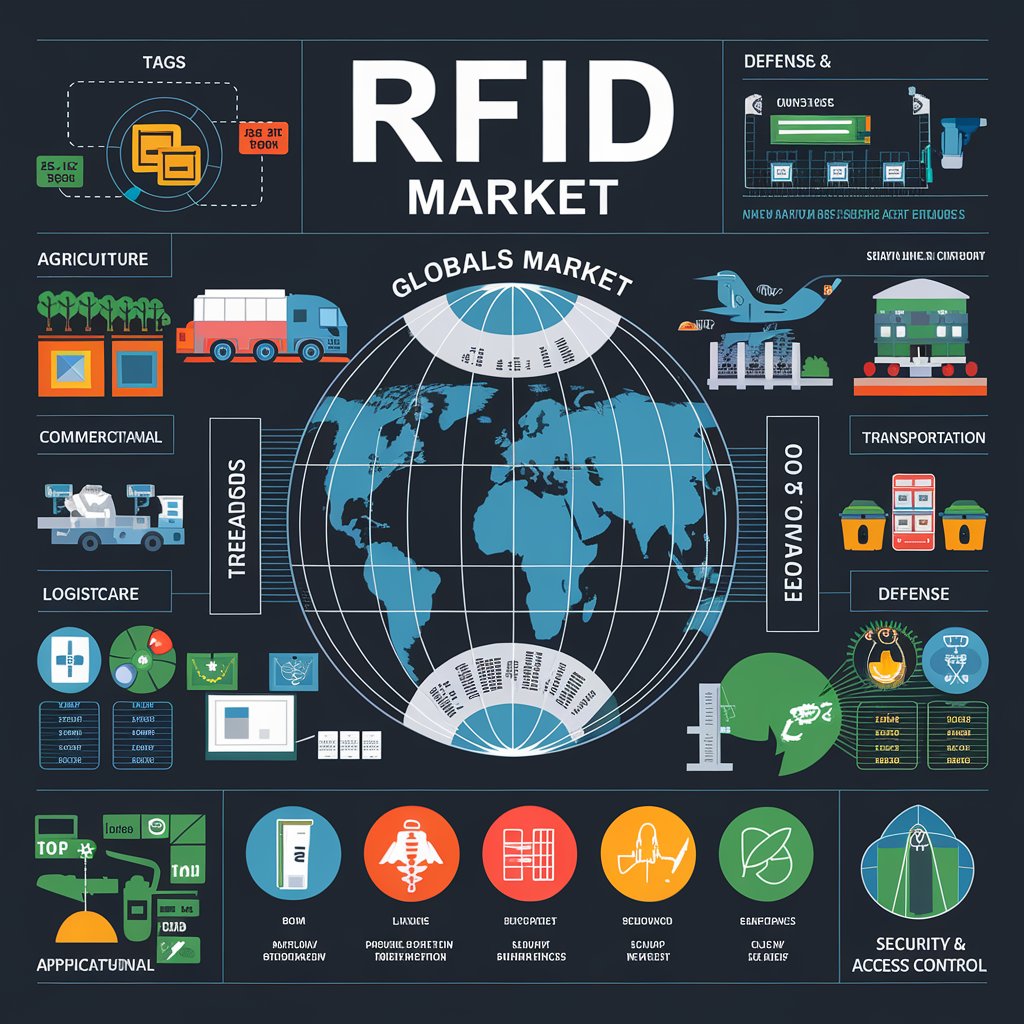Radio Frequency Identification (RFID) technology is rapidly transforming industries worldwide by offering a seamless and efficient way to track and manage assets. RFID uses radio waves to communicate between a reader and a tag attached to an object, allowing for automatic identification and data collection. This system works by sending electromagnetic signals from the reader to the RFID tag, which then responds by transmitting stored information back to the reader. This data can include product details, location, status, or other valuable information. Unlike traditional barcodes, RFID does not require direct line-of-sight scanning, making it far more versatile and efficient in numerous applications.
At its core, RFID technology involves two main components: RFID tags and RFID readers. RFID tags contain microchips and antennas that store data and allow them to transmit signals. These tags can either be active, powered by a battery, or passive, relying on the reader’s energy. The RFID reader sends out radio waves, which activate the tag and prompt it to send back the encoded data, allowing for real-time tracking.
Download PDF Brochure @ https://www.marketsandmarkets.com/pdfdownloadNew.asp?id=446

Types of RFID Systems
RFID systems can be classified into three types based on the frequency at which they operate. These include low-frequency (LF), high-frequency (HF), and ultra-high frequency (UHF) systems.
- Low-Frequency (LF) RFID Systems: Operating at frequencies between 30 kHz and 300 kHz, LF RFID systems are typically used for applications where short read ranges are required. They are commonly used in access control systems and animal tracking, as they can work well in environments with metal and liquid interference.
- High-Frequency (HF) RFID Systems: HF RFID operates at 13.56 MHz and is used in applications requiring moderate read distances, such as contactless payment systems, library management, and smart cards. The read range for HF RFID is typically 1-3 feet and is effective in environments where proximity to the reader is important.
- Ultra-High Frequency (UHF) RFID Systems: Operating between 860 MHz and 960 MHz, UHF RFID systems are commonly used for inventory tracking, logistics, and supply chain management. They offer a longer read range, typically up to 30 feet, and are ideal for environments that require high-speed tracking of multiple items.
Each type of RFID system offers unique advantages and is tailored to meet specific operational needs, from short-range identification in access control to long-range item tracking in logistics.
The Future of RFID Technology
The RFID market size is projected to reach USD 40.9 billion by 2032 from USD 15.8 billion in 2023; growing at a CAGR of 11.1% from 2023 to 2032.
RFID technology continues to evolve with advancements in hardware, software, and integration with other technologies. The future of RFID holds immense promise as it becomes more integrated with the Internet of Things (IoT) and AI-driven applications. We can expect RFID to become even more reliable and capable, with increased data capacity and greater energy efficiency. One key area of future growth is the integration of RFID with blockchain for supply chain transparency, where RFID tags will offer real-time updates and securely track goods as they move through various stages of the supply chain.
Another promising development is the use of RFID in autonomous vehicles. RFID tags integrated with AI and GPS systems could enable self-driving cars to communicate with infrastructure, improving navigation and safety. As RFID becomes more affordable and accessible, its use cases will expand, making it a key player in industries like healthcare, retail, agriculture, and logistics.
Innovative Uses of RFID in Agriculture
RFID is revolutionizing agriculture by enhancing traceability, livestock management, and crop monitoring. RFID tags are being used to track livestock, providing detailed information on health, breeding cycles, and movement. Farmers can use RFID technology to monitor their herds more efficiently, improving breeding outcomes and reducing losses due to disease or theft.
In crop management, RFID tags attached to farming equipment and tools enable real-time tracking of machinery, reducing downtime and improving operational efficiency. RFID is also being integrated with sensors and IoT systems to monitor soil conditions, water usage, and plant health. This data-driven approach allows farmers to optimize their resources, reduce waste, and improve crop yields while ensuring sustainability.
Additionally, RFID technology is used in food traceability, ensuring that consumers can trace the origins of their food products, which is crucial for safety and quality control. This innovation not only enhances productivity but also promotes sustainable farming practices.
Current Trends in the RFID Industry
The RFID industry is witnessing several key trends that are driving its adoption across various sectors:
- IoT Integration: RFID is increasingly being integrated with IoT devices to enable smarter, connected systems. This synergy allows businesses to capture more granular data, which can be analyzed to optimize operations, forecast demand, and improve supply chain efficiency.
- Miniaturization of RFID Tags: Advances in technology have led to the development of smaller and more cost-effective RFID tags. This makes RFID even more accessible for small businesses and enables its use in a wider array of applications, from healthcare to retail.
- Cloud Computing and RFID: The integration of RFID with cloud-based platforms is making it easier to store, analyze, and access RFID data remotely. Cloud solutions enable businesses to scale their RFID systems and share information seamlessly across departments and organizations.
- Enhanced Security Features: As data privacy becomes more crucial, the RFID industry is incorporating stronger encryption and authentication methods to ensure the security of RFID data and prevent unauthorized access.
- Sustainability Focus: RFID’s role in reducing waste and improving efficiency is making it a key tool for businesses aiming to improve their environmental sustainability. RFID-enabled tracking systems optimize the supply chain, reduce energy consumption, and minimize waste in logistics and inventory management.
Impact of IoT on RFID Technology
The Internet of Things (IoT) is dramatically enhancing the capabilities of RFID technology. IoT enables RFID systems to collect and transmit data to the cloud, where it can be processed, analyzed, and used to inform business decisions in real-time. This integration allows businesses to create more responsive, adaptive, and intelligent systems, particularly in supply chain management.
RFID-equipped IoT devices can provide continuous, real-time data on the status of goods, shipments, and even machinery. This integration improves operational efficiency, facilitates predictive maintenance, and enables businesses to respond proactively to changes in demand, production schedules, or inventory levels.
Moreover, the combination of RFID and IoT is creating opportunities for more sophisticated applications, such as smart cities, where RFID sensors can track traffic flow, monitor public services, and provide data for urban planning.
The Role of RFID in Smart Cities
RFID technology plays a critical role in the development of smart cities, where the goal is to create more efficient, sustainable, and livable urban environments. RFID systems are being used to monitor traffic flow, manage waste collection, and optimize energy usage. RFID-enabled smart parking systems can automatically identify available parking spaces, reducing traffic congestion and improving the overall urban experience.
In the transportation sector, RFID technology is being integrated into smart transportation systems to monitor the movement of vehicles, ensure timely deliveries, and reduce bottlenecks. Additionally, RFID-based access control systems are being used to enhance security in public spaces, ensuring that only authorized personnel or vehicles can enter sensitive areas.
Moreover, RFID’s integration with IoT systems in smart cities helps provide real-time data on everything from water usage to air quality, enabling municipalities to optimize public services and improve the quality of life for residents.
RFID technology is no longer just a tool for tracking inventory or managing assets. It is transforming industries by providing real-time, data-driven insights that optimize operations, improve efficiency, and foster innovation. From agriculture to healthcare, logistics to smart cities, RFID’s applications are vast and expanding rapidly. As the technology continues to evolve and integrate with IoT and other smart systems, RFID will undoubtedly play an even more prominent role in shaping the future of our connected world.
24World Media does not take any responsibility of the information you see on this page. The content this page contains is from independent third-party content provider. If you have any concerns regarding the content, please free to write us here: contact@24worldmedia.com

